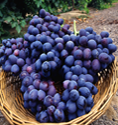Inulin May Help With Iron Uptake, Too
Chalk up another potential health benefit for inulin, a plant compound used in many foods that’s already been credited with boosting gut and colonic health and helping the body absorb dietary calcium.
Swine research funded in part by the Agricultural Research Service has found that this nondigestible carbohydrate—which reaches the colon intact, where it’s metabolized by beneficial bacteria—may help people absorb more iron from staple food plants that are rich in compounds that hamper iron uptake.
Iron is needed to form hemoglobin, which transports oxygen in the blood.
In Ithaca, New York, ARS plant physiologist Ross Welch, of the U.S. Plant, Soil, and Nutrition Laboratory, and Cornell University scientists Koji Yasuda, Karl R. Roneker, Xingen Lei, and Dennis D. Miller showed that young pigs fed corn- and soy-based diets supplemented with inulin absorbed more iron from their feed than pigs fed the same diet without inulin.
Welch says the discovery may prove significant in the worldwide fight against iron deficiency. “Without inulin, the colon absorbs very little iron from staple plant-based foods such as soybeans and corn because they contain high amounts of phytic acid that inhibit iron absorption.”
Young pigs were used, says Welch, because “They’re an excellent model for studying human iron nutrition. Their gastrointestinal tract anatomy and digestive physiology are very similar to those in humans.”
The scientists conducted two experiments, one with 24 weanling pigs over 5 weeks and one with 12 pigs over 6 weeks. The pigs were fed either a corn- and soy-based diet low in iron or the same diet supplemented so that 2 or 4 percent of it was composed of purified inulin.
“At 4 percent is where we saw a significant effect of inulin on iron absorption,” says Welch. “Pigs fed the 4-percent inulin diet showed a 28-percent improvement in absorbable iron and a 15-percent improvement in final blood hemoglobin concentration over those not fed inulin.
“Also, pigs fed the 4-percent-inulin diet were found to have higher soluble iron concentrations in the proximal, mid, and distal colon.”
Welch says that interlaced processes may explain why inulin boosts iron absorption during digestion: “The beneficial bacteria that ferment inulin in the colon release short-chain fatty acids that increase digestive acidity, and that causes mucosal cells to proliferate. This produces more cell surfaces where iron absorption takes place.”
He adds that within these gut mucosal cells, metabolic products from inulin fermentation also activate a gene—Divalent Metal Transporter 1, or DMT1—that’s responsible for a protein required for iron uptake by these cells.
The main source of inulin in the U.S. diet is wheat, although Welch says that onions and garlic are among the richest sources. Later studies will focus on breeding staple food crops with enhanced inulin levels.
In addition to ARS, the study was funded by the global HarvestPlus program, which is administered by the International Food Policy Research Institute in Washington, D.C., and the Colombia-based International Center for Tropical Agriculture.—By Luis Pons, formerly with ARS
"Inulin May Help With Iron Uptake, Too" was published in the January 2008 issue of Agricultural Research magazine.
This research is part of Human Nutrition, an ARS national program (#107) described on the World Wide Web at www.nps.ars.usda.gov.



